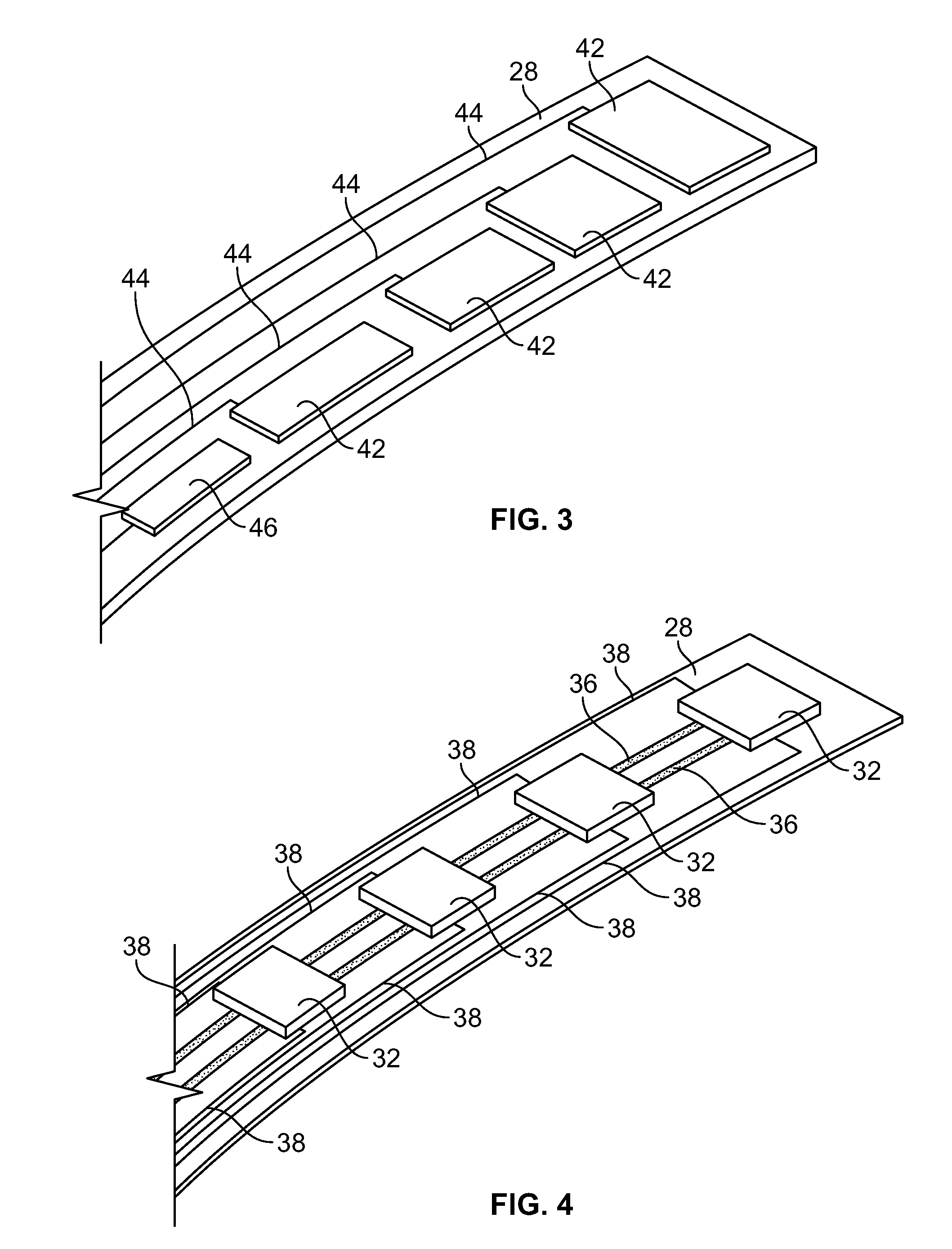Delivery device for localized delivery of a therapeutic agent
a delivery device and localized delivery technology, applied in the field of delivery of therapeutic agents, can solve the problems of reducing the accuracy of instrument placement, requiring careful monitoring, and requiring less than optimal injection, infusion, inflation or sample collection, etc., to reduce the loss of therapeutic agents, reduce the delivery and/or application of therapeutic agents, and reduce the effect of loss
- Summary
- Abstract
- Description
- Claims
- Application Information
AI Technical Summary
Benefits of technology
Problems solved by technology
Method used
Image
Examples
example 1
[0091]A device as illustrated in FIGS. 3-6 can be made by mounting Hall sensors and electroactive polymer on a strip, and mounting the strip onto a balloon surface. First, a flexible polymer strip is made. Nylon strips (VESTAMID®) can be extruded and cut having dimensions 1 meter long (approximately the length of the catheter) by 2 mm wide and a thickness of 20 micrometers. The strips are cleaned with HNO3 for 10 minutes and rinsed with deionized water. On one side, 10 parallel conductive lines (100 micrometers wide and 2 micrometers high with a spacing of 50 micrometers) are printed using an aqueous silver nanoparticle dispension SP100 (PChem Associates Inc., Bensalem, Pa.) and a MD-K-130 printing system from Microdrop (Microdrop Technologies GmbH, Muehlenweg 143, D-22844 Norderstedt, Germany). The conductive lines are for power supply to the sensors (2 conductive lines) as well as signal retrieval (8 conductive lines). On the opposite side of the strip, a number of lines as well a...
example 2
[0096]A device as illustrated in FIGS. 7-10 can be made by first making a polyimide inner tube with four copper conducting wires inserted in the wall. Micro Hall sensors can be obtained from Cryomagnetics Oak Ridge, Tenn. (http: / / www.cryomagnetics.com / hall-effect-sensor.php). The type HSU-1 comes without packaging with a sensing area of 100 micrometers squared. The surrounding ceramic area can be further reduced in size by laser ablating this material away using a 193 nm excimer laser to a final size of 200 by 200 micrometers. The wires of the Hall sensors are soldered to the wires of the inner tube after removing 10 mm of the distal end of the polymer wall of the inner tube using the same excimer laser. Two square cavities are ablated out of the inner tube 10 mm and 20 mm proximal to the distal end with a depth of 0.04 inches to fit both sensors. Both holes are aligned axially. The sensors and wires are folded backwards over the polymer inner tube whereby the sensors are placed bac...
example 3
[0099]A device as illustrated in FIGS. 14-15 is constructed by first making a polyimide inner tube with four conducting copper wires inserted in the wall as described in Example 2. Micro Hall sensors are attached to the inner tube in the same manner as in Example 2.
[0100]A tri-wing shaped soft silicon rubber piece (http: / / www.appliedsilicone.com / products-index.html, component part 40088) is cast and attached to an outer tube by using Loctite® 4981™ Super Bonder® Medical Device Adhesive. The rubber tri-shape has tipped wings such that upon retrieval in the delivery catheter they all will fold in the same direction. The three wings will make three channels (spaces between the wings), and one of them is closed by a silicon rubber membrane in place. In the valley of the closed chamber, one or more holes are punctured for the drug delivery ports.
[0101]The inner tube is fed through the outer tube and silicon wing shape and aligned such that the Hall sensors are located underneath the clos...
PUM
 Login to View More
Login to View More Abstract
Description
Claims
Application Information
 Login to View More
Login to View More - R&D
- Intellectual Property
- Life Sciences
- Materials
- Tech Scout
- Unparalleled Data Quality
- Higher Quality Content
- 60% Fewer Hallucinations
Browse by: Latest US Patents, China's latest patents, Technical Efficacy Thesaurus, Application Domain, Technology Topic, Popular Technical Reports.
© 2025 PatSnap. All rights reserved.Legal|Privacy policy|Modern Slavery Act Transparency Statement|Sitemap|About US| Contact US: help@patsnap.com



